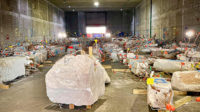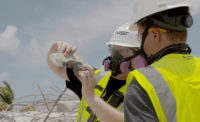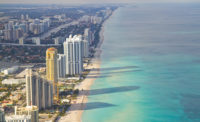The investigation into the 2021 collapse of the Champlain Towers South condominium in Surfside, Fla., has uncovered more deviations between the as-built conditions of the pool deck and the building’s design. But investigators emphasize their data are still preliminary as they continue to gather and test evidence from the collapse that killed 98 people.
Per structural design drawings for all slab-column connections, at least 25% of the slab top reinforcement bars specified for the column strip were to pass over the column, according to Glenn Bell, associate team lead for the U.S. Dept. of Commerce’s National Institute of Standards and Technology (NIST) investigation. However, samples investigators examined typically did not meet that requirement. In an example Bell highlighted, two rather than four of the 16 top bars were centered over the column in each direction.
Bell and Judith Mitrani-Reiser, team lead for the investigation, shared the update on their findings at the National Construction Safety Team Advisory Committee meeting Sept. 7. Investigators had previously reported at the committee’s June meeting about deviations in the pool deck which they said may have reduced safety margins against failure.
Also, investigators found spacing between the slab top reinforcing bars and the column strips was 20-40% wider than required by the design drawings, meaning there was less reinforcement in the vicinity of the columns than was required, Bell said in his latest presentation.
“These additional construction deviations further reduce the strength of the pool deck slab to column connections from the already compromised conditions that I reported in June,” he said.
The NIST team has so far extracted 301 cores and other concrete subsamples and tested 77 cores, Bell said. The average results of compressive strength tests have exceeded the specified design strength.
Investigators still have a lot of evidence to examine and test. Mitrani-Reiser said the team has more than 600 evidence specimens and more than 3 terabytes of photos and video. The team has identified 25 hard drives pulled from the wreckage, 14 of which may have come from DVRs and seven of which a forensic contractor is working to hopefully recover. The others were too badly damaged, Mitrani-Reiser said.
Videos are a valuable tool for the team as they piece together a moment-by-moment timeline of the collapse. Bell highlighted one video shot by a camera on a motion sensor inside one of the condo units in a part of Champlain Towers South that was involved in the early part of the collapse. Motion briefly caused the camera to record, but no motion was captured on the video. Then, a few seconds later, more motion activates the camera again, and this time material can be seen falling straight down from above. As the video continues, the material falls from an angle and the background becomes distorted. Bell said the team is continuing to analyze the video as it “holds important information about the collapse.”
 Graphic courtesy of NIST
Graphic courtesy of NISTThe NIST team is using all the evidence to prove or disprove more than two-dozen hypotheses about the potential causes of the collapse. While the data are still preliminary, Bell said preliminary evaluations have shown no evidence of large karstic voids that impacted Champlain Towers South’s foundations, and only small estimated potential settlements under structural loading—approximately ¼ in., which models showed would only have minimal impact on the pool deck structure.
Bell said the team anticipates substantial completion of technical work by the end of June 2024 and to complete a final report by the end of June 2025. In the next six months, investigators plan to complete a wind load history study, continue extraction and testing of materials, continue analyzing hard drives and further incorporate additional data into their digital models.
“We want our investigation of this failure to have a lasting impact to save future lives and to ensure that this never happens again,” Mitrani-Reiser said.






Post a comment to this article
Report Abusive Comment